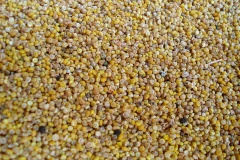Quinoa
| Infobox on Quinoa | |
|---|---|
| Example of Quinoa |  |
| Facts | |
| Origin | South America |
| Stowage factor (in m3/t) | |
| Humidity / moisture | 11% - 13,5% |
| Ventilation | |
| Risk factors | See text |
Quinoa
Description
Quinoa is a dicotyledonous, annual plant usually about 1–2 m high. It has broad, generally pubescent, powdery, smooth (rarely) to lobed leaves normally arranged alternately. The woody central stem is either branched or unbranched depending on the variety and may be green, red or purple. The panicles arise either from the top of the plant or from axils on the stem. The panicles have a central axis from which a secondary axis emerges either with flowers (amaranthiform), or bearing a tertiary axis carrying the flowers (glomeruliform). The green hypogynous flowers have a simple perianth and are generally bisexual and self-fertilizing. The fruits are about 2 mm in diameter and of various colours — from white to red or black depending on the cultivar.
Quinoa is highly variable due to a high complexity of different subspecies, varieties and landraces (plants or animals adapted to the environment in which they originated). However, in general it is undemanding and altitude-hardy. It is grown from coastal regions (Chile) to over 4,000 m (13,120 ft) in the Andes near the equator. However, most of the cultivars are grown between 2,500 m and 4,000 m. Depending on the variety, Quinoa's optimal growing conditions are in cool climates with temperatures that range from 25°F/−3°C, during the night, to near 95°F/35°C, during the day. Some cultivars can also withstand lower temperatures without damage. Light frosts normally do not affect the plants at any stage of development, except during flowering. Mid-summer frosts often occurring in the Andes during flowering lead to sterilization of the pollen. Rainfall conditions are highly variable between the different cultivars, ranging from 300 to 1,000 mm during growing season. Optimal for Quinoa growth is well-distributed rainfall during early growth and development and dry conditions during seed maturation and harvesting.
Quinoa, a species of goosefoot (Chenopodium), is a grain-like crop grown primarily for its edible seeds. It is a pseudocereal rather than a true cereal, or grain, as it is not a member of the grass family. As a chenopod, quinoa is closely related to species such as beets, spinach, and tumbleweeds.
The nutrient composition is very good compared with common cereals. Quinoa grains contain essential amino acids like lysine and good quantities of calcium, phosphorus, and iron.
After harvest, the grains need to be processed to remove the coating containing the bitter-tasting saponins. Quinoa grains are in general cooked the same way as rice and can be used in a wide range of dishes. Quinoa leaves are also eaten as a leaf vegetable, much like amaranth, but the commercial availability of quinoa greens is limited.
Application
Quinoa was of great importance in the diet of pre-Columbian Andean civilizations, secondary only to the potato, and was followed in importance by maize. In contemporary times, this crop has become highly appreciated for its nutritional value, as its protein content is very high (14% by mass), yet not as high as most beans and legumes. Nutritional evaluations of quinoa indicate that it is a source of complete protein. Furthermore, it is a good source of dietary fiber and phosphorus and is high in magnesium and iron. Quinoa is also a source of calcium, and thus is useful for vegans and those who are lactose intolerant. Quinoa is gluten-free and considered easy to digest. Because of all these characteristics, quinoa is being considered a possible crop in NASA's Controlled Ecological Life Support System for long-duration human occupied spaceflights.
Quinoa in its natural state has a coating of bitter-tasting saponins, making it unpalatable. Most quinoa sold commercially in North America has been processed to remove this coating. This bitterness has beneficial effects during cultivation, as the plant is unpopular with birds and therefore requires minimal protection. There have been attempts to lower the saponin content of quinoa through selective breeding to produce sweeter, more palatable varieties that have proven difficult due to cross pollination contamination.
The toxicity category rating of quinoa saponins treats them as mild eye and respiratory irritants and as a low gastrointestinal irritant. The saponin is a toxic glycoside, a main contributor to its hemolytic effects when combined directly with blood cells. In South America, Quinoa saponin has many uses outside of consumption, which includes detergent for clothing and washing, and as an antiseptic for skin injuries. High levels of oxalic acid in the leaves and stems are found in all species of the Chenopodium genus, but are also present in the related plant families of Polygonaceae and Amaranthaceae. The risks associated with quinoa are minimal, provided it is properly prepared and leaves are not eaten to excess.
Shipment / Storage
Shipped in multiwall paper bags with inner polyethylene lining (25 kg. net weight). Also in polypropylene bags and Big Bags. Line containers with kraft paper or corrugated cardboard and use Dry Bags.
See also Agricultural Products (in non refrigerated containers) and Grain
Risk factors
- Self-heating / Spontaneous combustion
- Moisture
- Contamination
- Mechanical influences
- Toxicity / Hazards to health
- Shrinkage / Shortage
- Insect infestation / Disease











